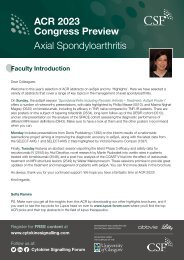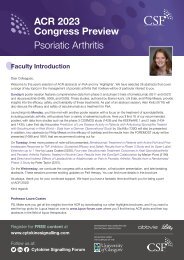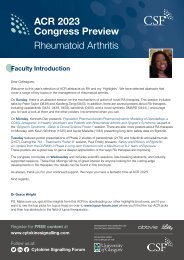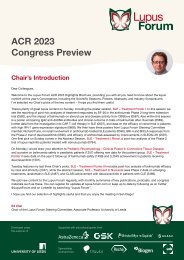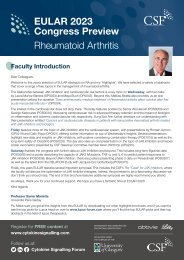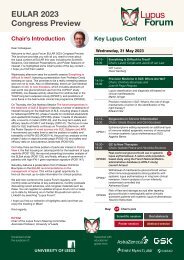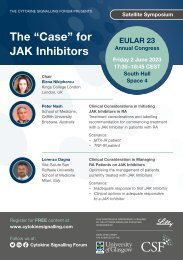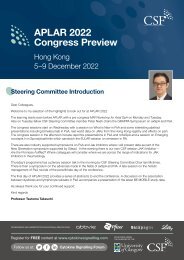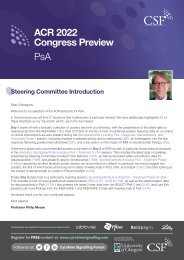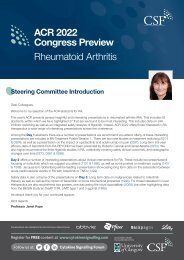EULAR 2017 CS Review
You also want an ePaper? Increase the reach of your titles
YUMPU automatically turns print PDFs into web optimized ePapers that Google loves.
Enhancing knowledge of the clinical<br />
importance of cytokine signalling<br />
The Cytokine Signalling Forum<br />
www.cytokinesignalling.com<br />
<strong>EULAR</strong> <strong>2017</strong><br />
Conference Highlights<br />
Cytokine Signalling Science<br />
Register for all this FREE content at<br />
www.cytokinesignalling.com<br />
www.cytokinesignalling.com<br />
info@cytokinesignalling.com<br />
@CytokineForum<br />
lnkd.in/PyqQPm<br />
Supported by an unrestricted educational grant<br />
from Pfizer Italia S.R.L., Lilly and R-Pharm.<br />
Developed under the auspices of the University of Glasgow
Chairman’s Welcome<br />
<strong>EULAR</strong> <strong>2017</strong> Conference Highlights<br />
Cytokine Signalling Science<br />
Dear <strong>CS</strong>F Member,<br />
Thank you for your continued support of the Cytokine Signalling Forum. We are now in our fourth year, and continue to strive to bring<br />
you the most up-to-date and interesting data in cytokine signalling. To that end, I am delighted to share with you our pick of the <strong>EULAR</strong><br />
highlights for <strong>2017</strong>. We have identified the most interesting and impactful abstracts being presented at this year’s meeting on both cytokine<br />
signalling and IL-6. I have also selected my ‘Chairman’s picks’: those abstracts that I feel are the most significant at this year’s congress.<br />
Cytokine Signalling<br />
Again, this year there is an interesting range of both basic and clinical science. There are several baricitinib posters covering durability<br />
and maintenance of efficacy [FRI0096], switching to monotherapy [SAT0058], and dose reduction [SAT0072]. The possibility of an<br />
anti-inflammatory biomarker profile in patients treated with filgotinib monotherapy is examined [THU0182], and the results of the DARWIN-3<br />
open label extension study up to 144 weeks are presented in Thursday’s poster session and tour [THU0173].<br />
Tofacitinib posters in RA concentrate on long-term safety and efficacy over eight years [THU0197] as well as an examination of<br />
cardiovascular risk factors [SAT0686], and safety and efficacy in patients with an inadequate response to conventional synthetic or biologic<br />
DMARDs [THU0185]. Real-world tofacitinib drug-retention data are also shared as a poster from the Swiss SCQM registry [THU0174];<br />
and real-world tofacitinib monotherapy data from the US CORRONA registry as an oral presentation [OP0022]. Three further oral<br />
presentations on Thursday and Friday will share exciting new data from the Phase 3 tofacitinib studies in psoriatic arthritis [OP0202;<br />
OP0216] as well as long-term effectiveness of live zoster vaccine in patients with RA, subsequently treated with tofacitinib [OP0230].<br />
IL-6<br />
Several abstracts showcase key data from the clinical programmes of sarilumab, sirukumab and tocilizumab.<br />
There are three key presentations on sarilumab, including patient-reported (PROs) from two Phase 3 studies in RA [FRI0240], and efficacy<br />
and patient-reported benefits of sarilumab monotherapy versus adalimumab monotherapy in the MONARCH study [SAT0202; OP0102].<br />
Sirukimab posters focus on Phase 3 data in RA, with efficacy and safety from the SIRROUND-T study [FRI0214], analyses of health-related<br />
quality of life and work productivity from SIRROUND-D and -T, respectively [FRI0246; FRI0251], and an integrated safety analysis of the<br />
SIRROUND programme [SAT0194].<br />
Tocilizumab oral presentations examine tapering and dose reduction strategies [OP0104] as well as the long-term safety profile seen in<br />
clinical trials and post-marketing populations [OP0105]. Tocilizumab posters look at real-world data, with clinical remission in the TOSPACE<br />
trial [SAT0183], and a pooled analysis of Phase 4 data across 22 countries [SAT0199].<br />
The following pages provide an overview of these topics and highlight my ‘Chairman’s picks’. Once again, thank you for your support and<br />
I hope you enjoyed <strong>EULAR</strong> <strong>2017</strong>!<br />
Yours,<br />
Prof. Iain McInnes
<strong>EULAR</strong> <strong>2017</strong> Conference Highlights<br />
Cytokine Signalling Science<br />
Highlights from <strong>EULAR</strong> <strong>2017</strong>: Cytokine Signalling<br />
During the <strong>EULAR</strong> <strong>2017</strong> annual meeting, many presentations and posters reported on<br />
cytokine signalling and related drugs. This document reviews the highlights.<br />
A separate highlights document covering interleukin 6 (IL-6) and related drugs is<br />
also available.<br />
ABT-494<br />
There were four posters and one publication-only abstract on ABT-494, a selective janus<br />
kinase (JAK)-1 inhibitor currently being evaluated in Phase 3 trials in rheumatoid arthritis<br />
(RA) at doses of 15 mg and 30 mg QD in an extended-release tablet formulation.<br />
Clinical efficacy in RA<br />
Strand, et al. presented a post hoc analysis from two Phase 2b trials (BALANCE-1<br />
and BALANCE-2), looking at changes in haemoglobin with ABT-494, and its relation to<br />
baseline levels of C-reactive protein (CRP). In 210 patients with RA, higher baseline CRP<br />
was associated with smaller mean decreases in haemoglobin at Week 12. They also<br />
found that ACR20 or DAS28-CRP ≤3.2 responders had smaller decreases in haemoglobin<br />
versus non-responders at Week 12. The authors concluded that effective treatment of<br />
RA-associated inflammation with ABT-494 may counterbalance the small haemoglobin<br />
reduction associated with JAK inhibition [THU0210].<br />
A second presentation from Strand, et al. shared early patient-reported outcomes (PROs)<br />
and clinical outcomes in inadequate responders (IR) to methotrexate (MTX; n=150) or<br />
tumour necrosis factor inhibitors (TNFi; n=166) from a post hoc analysis of Phase 2 trials.<br />
In both trials, significantly more patients receiving the 12 mg dose of ABT-494 reported<br />
improvements greater than the minimal important difference (MID) in RAPID3 (Routine<br />
Assessment of Patient Index Data) versus placebo at Week 2. Significantly more MTX-IR patients<br />
receiving 6 mg BID ABT-494 versus placebo also had improvements ≥MID in RAPID3<br />
(54% versus 30%). These responses were sustained through both trials in patients<br />
receiving the 12 mg dose. DAS28 and Clinical Disease Activity Index (CDAI) also showed<br />
fast and sustained responses to Week 12 in both MTX-IR and TNF-IR populations<br />
[SAT0217].
<strong>EULAR</strong> <strong>2017</strong> Conference Highlights<br />
Cytokine Signalling Science<br />
Pharmacokinetics<br />
Mohamed, et al. presented a poster on the pharmacokinetics of the extended-release<br />
compared to immediate-release formulations of ABT-494 in 24 healthy individuals.<br />
At steady-state, ABT-494 AUC 0-24<br />
ratio was 0.94, C max<br />
ratio was 0.91 and C min<br />
ratio was<br />
1.09 for the 15 mg QD regimen of the extended-release formulation relative to the 6 mg<br />
BID regimen of the immediate-release formulation. Similar results were shown for the 30 mg<br />
QD regimen of the extended-release formulation relative to the 12 mg BID regimen.<br />
All evaluated regimens were well-tolerated [THU0177].<br />
Mohamed, et al. also shared an abstract evaluating ABT-494 QT prolongation potential<br />
using an exposure-response analysis of data collected in early Phase 1 studies.<br />
They found no statistically significant relationship between the change from baseline in<br />
the QTcF interval and ABT-494 plasma concentrations at the expected therapeutic and<br />
supra-therapeutic plasma exposures for the doses being used in Phase 3 trials in<br />
RA patients [AB0432].<br />
Baricitinib<br />
Baricitinib had a strong presence, with a focus on Phase 3 efficacy results and the<br />
long-term extension studies.<br />
Clinical efficacy in RA<br />
Efficacy and safety of 423 patients switching to baricitinib monotherapy upon entering the<br />
long-term extension study (RA-BEYOND) was reported by Fleischmann, et al. At Week<br />
24 of the extension period, 47% of patients remained on monotherapy. Most of those<br />
who initiated MTX did so within 4 weeks. These patients tended to have worse disease<br />
control upon entry and during the study. No statistically significant changes in disease<br />
activity were observed in patients who were switched from combination to monotherapy.<br />
Clinically significant or consistent differences in serious infectious events, serious adverse<br />
event (SAEs), or AEs leading to study drug discontinuation were not seen in any of the<br />
arms, whether MTX was added or not [SAT0058].<br />
Smolen, et al. examined durability and maintenance of efficacy following prolonged<br />
treatment with baricitinib in the long-term extension. Approximately half the patients in<br />
the durability analyses had low disease activity (LDA) by Week 24, with similar proportions<br />
at Week 96. Three-quarters of patients demonstrated Health Assessment Questionnaire<br />
Disability Index (HAQ-DI) improvement by Week 12 and more than half achieved the<br />
minimum clinically important difference at Week 96. Most responders at entry into the<br />
long-term extension maintained response to Week 96 [FRI0096].
<strong>EULAR</strong> <strong>2017</strong> Conference Highlights<br />
Cytokine Signalling Science<br />
Takeuchi, et al. also presented results from the long-term extension, showing that among<br />
patients who achieved sustained disease control with baricitinib 4 mg, dose reduction to<br />
2 mg resulted in significant increases in disease activity at 12, 24, and 48 weeks; however,<br />
most patients in both groups maintained the state of LDA or remission. Rescue rates were<br />
7.3% for 4 mg and 17.1% for the 2 mg dose, and most rescued patients could regain LDA<br />
or remission. Dose reduction was associated with a lower rate of non-serious infections;<br />
rates of SAEs and AEs leading to discontinuation were similar across groups. The authors<br />
concluded that 4 mg QD was the most efficacious dose of baricitinib for patients with RA<br />
[SAT0072].<br />
52-week <strong>EULAR</strong> responses from 1305 patients in RA-BEAM were presented in a poster<br />
by Kvien, et al. At Week 4, moderate <strong>EULAR</strong> responses were experienced by 37.3%,<br />
62.0%, and 60.3% of patients on placebo, baricitinib, and adalimumab, respectively.<br />
The mean MTX dosage was 15 mg/week, and 59% were taking concomitant oral<br />
glucocorticoids. The cumulative incidence for first transition to good <strong>EULAR</strong> response at<br />
Weeks 12, 24, and 52 was higher in patients who reached moderate response at Week<br />
4 on baricitinib than those who reached moderate response on adalimumab; cumulative<br />
incidence for first transitions to subsequent no response was higher in patients who<br />
achieved moderate response at Week 4 on adalimumab than baricitinib [SAT0070].<br />
In a post hoc analysis of Phase 3 data, Curtis, et al. showed that patients with CDAI<br />
≤35–36 at baseline achieved sustained LDA more frequently and more rapidly than those<br />
in the higher disease category at baseline. In patients with higher disease activity at<br />
baseline, a more robust response was observed with the baricitinib 4 mg dose than with<br />
the 2 mg dose [AB0235].<br />
Combe, et al. also performed a post hoc analysis of 5 studies to establish the impact<br />
of comorbidities on clinical outcomes. Treatment with baricitinib 4 mg showed similar<br />
effect in terms of efficacy and safety in patients with selected comorbidities, including<br />
depression, osteoporosis, cardiovascular events, and hepatic impairment. No trends<br />
were noted in each comorbidity subgroup for increased risk of events after treatment with<br />
baricitinib compared with placebo [FRI0086].<br />
A further post hoc analysis from Curtis, et al. assessed disease activity in patients who<br />
achieved CDAI ≤10 at ≥1 visit (LDA) or at ≥2 consecutive visits (sustained LDA) within<br />
the 24-week originating study and continued into the long-term extension. The most<br />
robust benefit was observed with baricitinib 4 mg treatment, which required shorter time<br />
to response, than the 2 mg dose. This was observed in both the short- and long-term<br />
in patients with an inadequate response to conventional systemic disease-modifying<br />
antirheumatic drugs (csDMARD-IR) or biologic DMARDs (bDMARD-IR) patients [FRI0089].
<strong>EULAR</strong> <strong>2017</strong> Conference Highlights<br />
Cytokine Signalling Science<br />
Emery, et al. reported on temporary interruptions of treatment during the Phase 3 studies,<br />
caused by AEs, abnormal laboratory results, or at the investigator’s discretion. There were<br />
modest symptom increases during interruption compared to the last pre-interruption<br />
value, with a return to pre-interruption values or better after resumption of study drug<br />
[FRI0124].<br />
Pincus, et al. shared a post hoc analysis of RA-BEAM in MTX-IR patients, designed to<br />
compare improvement according to RAPID3, DAS 28-ESR (erythrocyte sedimentation<br />
rate), and CDAI. Improvement from baseline to Week 24 ranged from 19.2–37.0%<br />
in placebo patients, 40.0–65.9% in baricitinib-treated patients, and 37.6–60.9% in<br />
adalimumab-treated patients. Changes according to RAPID3-like, DAS28-ESR and CDAI<br />
were similar in the three treatment groups. The authors concluded that RAPID3 is feasible<br />
to provide quantitative, standard medical history data [SAT0069].<br />
Kavanaugh, et al. analysed data from RA-BEAM and RA-BUILD to assess whether<br />
concomitant use of csDMARDs altered the response or safety outcomes to baricitinib in<br />
patients with RA, and evaluated the effect of concomitant corticosteroid use on efficacy.<br />
The differences in clinical efficacy between baricitinib 4 mg and placebo at 12 weeks<br />
was similar regardless of the number or type of csDMARDs concomitantly used, or<br />
concomitant use of corticosteroids. Rates of SAEs and discontinuation due to AEs were<br />
comparable regardless of the number or type of csDMARDs used or corticosteroid use<br />
[THU0078].<br />
Curtis, et al. also looked at RA-BEAM and RA-BUILD to ascertain the effects of smoking<br />
on the efficacy of baricitinib in 290 patients. They found that smoking status at baseline<br />
did not affect clinical outcomes over 24 weeks with baricitinib; conversely, smokers who<br />
received placebo were numerically less likely than non-smokers receiving placebo to<br />
achieve most clinical outcomes. The effect of baricitinib on modified total Sharp score<br />
was more pronounced among non-smokers [THU0114].<br />
In a network meta-analysis, Lee, et al. examined the efficacy and safety of baricitinib in<br />
patients with active RA using direct and indirect evidence from 3461 patients in 7 clinical<br />
trials. ACR20 response was significantly higher for baricitinib 4 mg in combination with<br />
DMARDs than in the placebo plus DMARD group. A ranking probability calculation<br />
indicated that baricitinib 4 mg plus DMARD was likely to elicit the best ACR20 response<br />
rate, followed by (in order) baricitinib 4 mg monotherapy, baricitinib 2 mg plus DMARD,<br />
adalimumab 40 mg plus MTX, and lastly placebo plus DMARD. By contrast, the safety<br />
based on the number of treatment-emergent AEs did not differ significantly among the<br />
5 interventions [THU0213].
<strong>EULAR</strong> <strong>2017</strong> Conference Highlights<br />
Cytokine Signalling Science<br />
Structural efficacy in RA<br />
Structural results from RA-BEGIN were reported by van der Heijde, et al. Patients were<br />
classified into two groups based on their DAS28-CRP. In patients who achieved sustained<br />
low DAS28-CRP scores, progression rates compared with MTX were reduced to a similar<br />
degree with baricitinib monotherapy or in combination with MTX. Compared with MTX in<br />
patients who did not achieve sustained low DAS28-CRP scores, progression rates were<br />
reduced most markedly with combination therapy [THU0088].<br />
van der Heijde, et al. also presented 2-year structural results from the long-term extension<br />
study. At Year 2, progression was significantly lower in those who received initial baricitinib<br />
(including monotherapy) in the Phase 3 trial versus initial MTX in DMARD-naïve patients.<br />
In MTX/csDMARD-IR patients, progression with initial baricitinib was significantly lower<br />
than initial placebo, and similar to initial adalimumab [FRI0087].<br />
Patient-reported outcomes in RA<br />
Taylor, et al. evaluated the effect of baricitinib on pain reduction compared with adalimumab<br />
or placebo in MTX-IR and bDMARD-IR patients in RA-BEAM and RA-BEACON.<br />
A significantly greater proportion of patients treated with baricitinib 4 mg achieved ≥30%<br />
and ≥50% pain improvement as early as Week 1 compared with placebo, and as early<br />
as Week 4 compared with adalimumab. A significant pain improvement of ≥70% was<br />
achieved at Week 12 for 4 mg baricitinib-treated patients compared with placebo and<br />
adalimumab. Pain improvement of ≥30%, ≥50%, and ≥70% with the baricitinib 2 mg<br />
dose was significant compared with placebo by Week 12, and sustained through Week 24<br />
[SAT0055].<br />
Fautrel, et al. presented the PROs in patients who achieved LDA or remission in the<br />
Phase 3 RA-BEAM study. Among patients in LDA or remission, significantly greater<br />
improvements in Pain and HAQ-DI scores were observed with baricitinib than<br />
adalimumab or placebo, and significantly greater improvements in morning joint stiffness<br />
were observed with baricitinib or adalimumab than placebo. Patients in remission or LDA<br />
showed greater numerical improvement and less residual impairment in other PROs with<br />
baricitinib or adalimumab than with placebo [THU0081].
<strong>EULAR</strong> <strong>2017</strong> Conference Highlights<br />
Cytokine Signalling Science<br />
Safety in RA<br />
Takeuchi, et al. analysed changes in absolute lymphocyte count and cell subsets (L<strong>CS</strong>)<br />
in the Phase 3 RA-BEGIN study. Low B and NK cell counts were common at baseline,<br />
and post-baseline changes within normality occurred in all treatment groups. Compared<br />
with MTX, baricitinib was not associated with an increase in the percentage of patients<br />
with low NK or CD8+ cell counts, while baricitinib in combination with MTX did show an<br />
increase in the percentage of patients with a low NK cell count. Changes appeared to<br />
be distinct for L<strong>CS</strong>, suggesting different mechanisms may underscore the effect of JAK<br />
inhibition. The authors noted that whether low NK or CD8+ cell counts predispose to<br />
increased risk for serious infections or Herpes zoster was difficult to assess owing to few<br />
patients with low counts experiencing these events [AB0281].<br />
Changes in absolute neutrophil counts (ANC), absolute leukocyte counts (ALC), and platelet<br />
counts following once-daily oral administration of baricitinib were characterised by Kremer,<br />
et al. using pooled data from 6 Phase 2 and 3 studies. Treatment with baricitinib<br />
was associated with a decrease in ANC and an increase in ALC and platelets, which<br />
stabilised over time and returned to baseline with prolonged treatment (ALC) or treatment<br />
discontinuation (ANC and platelets). No associations were observed between either ANC<br />
decreases and infections, or between thrombocytosis and thromboembolic events [FRI0090].<br />
Kay, et al. evaluated baseline and subsequent changes in haemoglobin and related<br />
laboratory parameters in patients with RA treated with baricitinib 2 mg or 4 mg QD,<br />
placebo, or active comparator (MTX or adalimumab). The proportions of RA patients with<br />
treatment-emergent abnormally low haemoglobin did not differ significantly between<br />
baricitinib and placebo. Reductions in haemoglobin (including to Grade 3 or higher),<br />
were generally not associated with adverse outcomes. Despite concerns about the<br />
impact of JAK2 inhibition on erythropoietin signalling, following initial declines incident<br />
to phlebotomy, dose-dependent increases in erythropoietin, total iron, and total iron<br />
binding capacity with return to baseline in reticulocyte and haemoglobin were observed<br />
with baricitinib. The authors concluded that this suggests that homeostatic mechanisms<br />
counterbalance the pharmacologic effect of JAK inhibition on erythropoietin signalling,<br />
and that baricitinib treatment enhances iron utilisation markers associated with anaemia<br />
of chronic disease [FRI0092].<br />
A meta-analysis of serious infections with baricitinib, tofacitinib and bDMARDs was<br />
presented as a poster, by Strand, et al. The results showed no significant difference from<br />
control for both doses of baricitinib, consistent with analyses of tofacitinib and bDMARDs.<br />
There were limited data to assess the incidence of serious infectious events for baricitinib<br />
(4 mg) monotherapy versus barictinib in combination with MTX. Incidence rates for<br />
baricitinib were for 2 mg and 3.67 for the 4 mg dose [THU0211].
<strong>EULAR</strong> <strong>2017</strong> Conference Highlights<br />
Cytokine Signalling Science<br />
Filgotinib<br />
Filgotinib is a selective JAK1 inhibitor (previously known as GLPG0634 or GS-6034).<br />
There were a handful of posters looking at basic science, and one showcasing clinical<br />
efficacy data from the Phase 2b DARWIN studies.<br />
Clinical efficacy and safety in RA<br />
Alten, et al. presented the long-term data from DARWIN-3 in 739 patients who entered<br />
the long-term extension after initial treatment for 24 weeks. Based on an observed case<br />
analysis, 84%, 65%, 44% and 51% of patients reached ACR20, ACR50, ACR70 and<br />
DAS28(CRP) remission at Week 60, respectively. Treatment-emergent AEs (157.7 per<br />
100 patient-years), SAEs (5.3 per 100 patient-years) and serious infections (1.9 per<br />
100 patient-years) occurred at similar rates as seen in the core studies; however,<br />
infections decreased from 15% (Weeks 0–12) to 5% (Weeks 85–96). Sixteen cases of<br />
Herpes zoster were reported (1.2 per 100 patient-years), 6 non-non-melanoma skin<br />
cancer (NMSC) malignancies (0.5 per 100 patient-years) and 1 major adverse cardiac<br />
event (MACE)<br />
(0.1 per 100 patient-years) [THU0173].<br />
Basic science<br />
Kavanaugh, et al. investigated the mode of action of filgotinib when used as monotherapy<br />
in RA patients by analysing the impact of the drug on a broad panel of immune<br />
modulators in the serum. Following treatment with filgotinib 100 mg QD and 200 mg<br />
QD, there were significant reductions in cytokines important in expansion and activity of<br />
multiple T-cell subsets and innate immunity, including proinflammatory cytokines (IL-6,<br />
IL-1β, and TNFα), TH1-related (IL-2, IFN-γ and IL-12), TH2-related (IL-4, IL-5, and IL-13)<br />
and TH17-related cytokines (IL-1β, IL-6, IL-17A, IL-21 and IL-23). All doses of filgotinib<br />
also reduced the B- and T-cell development cytokine IL-7. In contrast, IL-8 was not<br />
affected by filgotinib [THU0182].<br />
Taylor, et al. used serum samples to assess the effect of filgotinib on markers of<br />
inflammation in patients with RA taking background MTX. They found that filgotinib<br />
induced a dose-dependent and significant decrease in a variety of biomarkers implicated<br />
in the pathogenesis of RA, including inflammation (IL-1β, IL-6, TNFα and SAA), matrix<br />
degradation and cartilage destruction (MMP1 and MMP3), immune cell trafficking<br />
(CXCL10, ICAM-1 and VCAM-1) and angiogenesis (VEGF). Cytokines involved in TH1<br />
(IFN-γ, IL-2, IL-12) and TH17 (IL-1β, IL-6, IL-21, IL-23) cell subset differentiation and<br />
activity were significantly decreased. Additionally, decrease in the B-cell chemoattractant<br />
CXCL13 and the myeloid growth factor GM-<strong>CS</strong>F support theanti-inflammatory effects of<br />
filgotinib treatment [THU0206].
<strong>EULAR</strong> <strong>2017</strong> Conference Highlights<br />
Cytokine Signalling Science<br />
The effect of filgotinib on multi-biomarker disease activity (MBDA) scores in MTX-IR<br />
patients with active RA were presented by Genovese, et al. Filgotinib-treated patients<br />
had reductions in MBDA from baseline at both 100 mg and 200 mg QD. At Weeks 4 and<br />
12, these reductions were significantly different from the placebo group. Most individual<br />
components contributed to the decrease in MBDA, but the largest reductions were<br />
observed for serum amyloid A (SAA), CRP, and IL-6, and biomarkers of joint damage.<br />
The authors concluded that these findings were consistent with the filgotinib efficacy<br />
observed in patients with RA over 12 weeks [THU0205].<br />
Blanqué, et al. presented a mouse model, where systemic expression of IL-23 generated<br />
a PsA phenotype that was associated with altered gene expression in diseased tissues.<br />
The authors found that a strong interferon signature was reversed by filgotinib, as were<br />
several inflammation and disease markers [FRI0428].<br />
A second mouse model in PsA was detailed by Robin-Jagerschmidt, et al. in an oral<br />
presentation. The authors found that high levels of IL-23 were maintained during the timecourse<br />
of the study and were correlated with severity of finger and paw swelling.<br />
Filgotinib significantly improved clinical scoring and tended to prevent neutrophil or<br />
granulocyte infiltrate in paw, with a significant effect being showed at an earlier timepoint.<br />
Filgotinib reversed some up-regulated inflammatory genes in enthesis and/or fingers<br />
(CCL20, CXCL1, IL‐22, MMP9 and TNFa) and reduced the target-related gene Mx2.<br />
Filgotinib significantly counteracted pSTAT3 induction in the subcutaneous area, further<br />
demonstrating target engagement in the diseased tissue. Finally, they noted that – in line with<br />
previous findings – Mx2 expression in colon was slightly reversed by filgotinib [OP0161].<br />
Tofacitinib<br />
As in previous years, there continued to be large numbers of presentations on the JAK<br />
inhibitor tofacitinib. The vast majority related to long-term and real-world use in RA, but<br />
there were also data in psoriatic arthritis (PsA) and ankylosing spondylitis (AS).<br />
Clinical efficacy in RA<br />
Fleischmann, et al. gave a late-breaking oral presentation of the results from ORAL<br />
STRATEGY, a Phase 3b/4 trial of tofacitinib versus adalimumab head-to-head,<br />
non-inferiority trial in 1146 patients. At Month 6, non-inferiority was demonstrated for<br />
tofacitinib 5 mg BID plus MTX versus adalimumab plus MTX (P
<strong>EULAR</strong> <strong>2017</strong> Conference Highlights<br />
Cytokine Signalling Science<br />
Wollenhaupt, et al. presented the efficacy and safety data up to 8 years. In total, 4967<br />
patients were treated with tofacitinib 5- or 10 mg BID, either as monotherapy or with<br />
background DMARDs. Over a mean of 1215 days, 77.4% of patients maintained their<br />
initial dose, and clinical responses were sustained from Month 1 to Month 90 [THU0197].<br />
Phase 3 data from ORAL Solo, ORAL Start, ORAL Step, ORAL Scan, ORAL Sync, ORAL<br />
Standard were also pooled in an analysis by Schwartzman, et al. Tofacitinib 5- and<br />
10 mg BID demonstrated efficacy in patients with moderate and severe RA with more<br />
than 7 years’ mean disease duration. By Month 3, patients with severe versus moderate<br />
baseline disease activity had greater improvements in disease activity and physical<br />
functioning. Higher proportions of patients with moderate versus severe baseline disease<br />
activity achieved remission, LDA or normal physical functioning [AB0436].<br />
Tesser, et al. evaluated tofacitinib efficacy and safety using pooled data from 8 Phase 2<br />
and 6 Phase 3 trials in non-MTX csDMARD-IR and MTX-IR (second-line) populations.<br />
Tofacitinib 5- and 10 mg BID achieved higher ACR responses and greater changes<br />
from baseline in DAS28-4(ESR) and HAQ-DI scores versus placebo at Month 3 in both<br />
populations. Numerically higher proportions of non-MTX csDMARD-IR patients achieved<br />
efficacy outcomes versus second-line population. AE frequency was generally lower in<br />
non-MTX csDMARD-IR patients versus the second-line population [THU0195].<br />
Kaine, et al. demonstrated the re-establishment of efficacy after temporary withdrawal<br />
of tofacintib in 199 patients in a sub-study of an open-label vaccine study. Laboratory,<br />
clinical and PRO results suggested that the efficacy of tofacitinib 10 mg BID can be<br />
re-established following loss of efficacy during temporary 2-week treatment discontinuation.<br />
AEs were experienced by 35.4% and 49.5% of patients receiving interrupted and<br />
continuous treatment, respectively [THU0193].<br />
Structural efficacy in RA<br />
Gaylis, et al. reported on clinical and structural responses using step-up doses in a<br />
treat-to-target approach in 20 patients with RA. Over a 12-week period, six patients<br />
remained at 5 mg BID and 14 escalated to 10 mg BID. In the 5 mg group, there was no<br />
change in erosions. However, in the 10 mg group, nine patients showed no change in<br />
erosions, one regression and one progression. Overall, five patients showed no change<br />
in synovitis and six showed regression, and seven showed no change in osteitis, three<br />
showed regression and one showed progression [AB0261].
<strong>EULAR</strong> <strong>2017</strong> Conference Highlights<br />
Cytokine Signalling Science<br />
Patient-reported outcomes in RA<br />
Aletaha, et al. presented the magnitude and duration of early response with tofacitinib in a<br />
post hoc analysis of ORAL Solo and ORAL Sync. DMARD-IR patients with active RA<br />
receiving tofacitinib with or without csDMARDs appeared to show greater improvements<br />
compared with placebo in HAQ-DI, and Pain as early as Week 2. Responses were<br />
maintained or improved through Month 3 for those receiving monotherapy, or Month 6 for<br />
those receiving background csDMARDs [THU0186].<br />
PROs were also examined by Yamanaka, et al. in Japanese patients with RA. Data for<br />
238 patients from 2 12-week randomised dose-finding Phase 2 studies found that<br />
tofacitinib 5- and 10 mg BID demonstrated significantly greater improvements from<br />
baseline versus placebo in Patient’s Global Assessment of Arthritis (PtGA), Physician’s<br />
Global Assessment of Arthritis (PGA), HAQ-DI, Pain, Functional Assessment of Chronic<br />
Illness Therapy – Fatigue (FACIT-F), Medical Outcomes Study (MOS) Sleep Scale and in<br />
four of the eight Short-Form Health Survey (SF-36) domain scores [THU0191].<br />
Li, et al. also looked at PROs in RA, this time in 216 Chinese patients in the Phase 3<br />
study ORAL Sync study. At Month 3, tofacitinib resulted in significantly greater changes<br />
in HAQ-DI, PtGA, Pain and SF-36 Physical Component Summary scores versus placebo<br />
[THU0215].<br />
Efficacy and patient-reported outcomes in PsA<br />
Gladman, et al. and Mease, et al. gave oral presentations of recent Phase 3 data in PsA<br />
[OP0202; OP0216]. Gladman, et al. covered TNFi-IR patients from the OPAL Beyond<br />
study. Superior ACR20 responses were seen as early as Week 2, and both ACR20 and<br />
HAQ-DI significantly improved with both tofacitinib doses versus placebo at Month 3,<br />
which were maintained to Month 6. No new safety risks were identified compared to<br />
those seen in previous studies in other indications [OP0202]. Mease, et al. presented<br />
similar results in csDMARD-IR, TNFi-naïve patients [OP0216].<br />
Strand, et al. presented PROs from two Phase 3 studies in PsA (OPAL Broaden and<br />
OPAL Beyond). Patients receiving tofacitinib 5- and 10 mg BID reported improved PROs<br />
compared with placebo. Greater improvements in PtGA and Arthritis Pain were observed<br />
as early as Week 2 through Month 3 with both tofacitinib doses compared with placebo in<br />
both studies (P≤0.05) [AB0794].
<strong>EULAR</strong> <strong>2017</strong> Conference Highlights<br />
Cytokine Signalling Science<br />
Phase 3 data from OPAL Balance, an open-label long-term extension trial in PsA,<br />
were presented in a poster by Nash, et al. Efficacy was maintained to Month 15, with<br />
improvements reported in joint, skin and quality of life measures [FRI0509].<br />
Nash, et al. also presented an integrated efficacy analysis of pooled data from OPAL<br />
Broaden and OPAL Beyond. In these csDMARD-IR/TNFi-naïve and TNFi-IR patients,<br />
tofacitinib 5- and 10 mg BID were superior to placebo at Month 3 across four PsA disease<br />
domains: peripheral arthritis, psoriasis, enthesitis and dactylitis [SAT0469].<br />
Efficacy in AS<br />
Maksymowych, et al. showed that tofacitinib treatment is associated with attainment of<br />
the minimally important reduction in axial MRI inflammation in 164 patients with AS in a<br />
16-week Phase 2 dose-ranging study. Tofacitinib 2-, 5- and 10 mg BID improved mean<br />
SPondyloArthritis Research Consortium of Canada (SPARCC) scores versus placebo,<br />
and approximately three-times more patients achieved minimally important changes in<br />
sacroiliac joint or spine in the pooled tofacitinib group versus placebo [THU0352].<br />
Safety in RA<br />
In the Wollenhaupt, et al. 8-year analysis reported above [THU0197], 47.7% of patients<br />
discontinued. The most common AE classes were infections and infestations (68.9%)<br />
and musculoskeletal/connective tissue disorders (39.0%). Overall, safety was consistent<br />
through to Month 105 [THU0197].<br />
Charles-Schoeman, et al. reported on the risk factors for major AEs in the pooled Phase 3<br />
and long-term extension studies. In 4076 patients, 52 MACE cases occurred over 12 873<br />
patient-years of exposure (incidence rate: 0.4 patients with events per 100 patient-years).<br />
At baseline, patients with MACE were older, had a higher mean body mass index (BMI),<br />
longer mean RA disease duration, and were more likely to have a history of diabetes and<br />
hypertension compared with patients without MACE events. Increases in LDL-c and total<br />
cholesterol (TC) after 24 weeks of tofacitinib therapy were not associated with future MACE<br />
risk. Increases in HDL-c and decreases in TC:HDL-c ratio after 24 weeks of tofacitinib<br />
therapy were associated with a reduced future MACE risk. The authors found that increases<br />
in ESR after 24 weeks may be associated with an increased future MACE risk [SAT0686].<br />
In a second poster from Charles-Schoeman, et al., tofacitinib was examined in<br />
inadequate responders to csDMARDs or one or more bDMARDs. Prior to initiating<br />
tofacitinib, bDMARD-IR patients had longer RA disease duration, greater disease burden<br />
and more corticosteroid use compared with csDMARD-IR patients. SAEs were more<br />
common among bDMARD-IR versus csDMARD-IR patients, but SAE rates were not<br />
higher in those who had failed two or more bDMARDs compared with those who had<br />
failed only one [THU0185].
<strong>EULAR</strong> <strong>2017</strong> Conference Highlights<br />
Cytokine Signalling Science<br />
Winthrop, et al. showed the long-term effectiveness of live zoster vaccine in 100 patients<br />
who continued to receive tofacitinib in ORAL Sequel. Five cases (not adjudicated) of<br />
Herpes zoster occurred up to 741 days post vaccine after initiation of tofacitinib.<br />
Four cases were monodermatomal, and 1 involved five dermatomes, but all cases<br />
resolved with treatment. Three cases had undetectable ELISPOT measures at baseline<br />
and Week 6 post vaccination, indicating a lack of varicella zoster virus (VZV) specific<br />
immunity. Two cases responded adequately to vaccination by both immunoglobulin<br />
G (IgG) and ELISPOT measures, but had lower than average VZV IgG levels, both at<br />
baseline and at Week 6. Overall, live zoster vaccine prior to treatment with tofacitinib is<br />
effective at boosting IgG levels and cell-mediated immunity towards VZV [OP0230].<br />
The first report of an increase in BMI with tofacitinib was presented by Novikova, et al.<br />
in a report of 28 patients with RA. There was an increase in BMI of less than 5% in 39%<br />
of patients, 5–10% increase in 25% of patients, and greater than 10% increase in 21%<br />
of patients, respectively. These changes in BMI correlated negatively with DAS-28 and<br />
Simple Disease Activity Index (SDAI) at baseline, and were independent of tofacitinib dose<br />
or use of cardioprotective therapy. An increase in TC from 4.60 to 5.45 (P=0.001) was<br />
observed in patients who were not receiving statins; co-administration of tofacitinib and<br />
statins resulted in significant favourable changes in LDL-and HDL-c [FRI0231].<br />
Gomez-Reino, et al. shared the results of a systematic review and meta-analysis of<br />
malignancies, excluding NMSC, in patients with RA treated with tofacitinib or bDMARDs.<br />
The authors used the tofacitinib clinical trial dataset of 6194 patients with a total exposure<br />
of 19385 patient-years and compared it to 64 bDMARD articles, representing 58 unique<br />
studies and approximately 27000 patients. The incidence rate of malignancy for tofacitinib<br />
was 0.89 (95% CI 0.76, 1.04) compared with estimated incidence rates of 0.75 (0.56,<br />
1.01) for abatacept, 1.06 (0.41, 2.74) for rituximab, 1.02 (0.69, 1.52) for tocilizumab and<br />
0.95 (0.79, 1.14) for TNFi – suggesting that the incidence of non-NMSC malignancies in<br />
patients treated with tofacitinib is within a similar range to those reported in published<br />
interventional studies of similar RA populations treated with approved bDMARDs [THU0196].<br />
Post-marketing surveillance data from Japan was shared by Mimori, et al. In this 6-month<br />
interim analysis of 2387 tofacitinib-treated patients, 594 patients (24.9%) discontinued<br />
treatment, mainly due to AEs (9.9%) or lack of effectiveness (9.4%). In total, 1793 patients<br />
continued treatment for 6 months. At least one AE was observed in 34.1% of patients,<br />
the most frequent of which was Herpes zoster (3.3%), including 12 serious cases. SAEs<br />
occurred in 8.0%; the most frequent were pneumonia (0.8%), interstitial lung disease<br />
(0.6%) and a definition of ‘condition aggravated’ (0.5%). Infections (12.7%) were serious<br />
in 3.7% of patients. Thirteen patients reported malignancy, including ovarian cancer<br />
(0.1%), diffuse large B-cell lymphoma (0.1%) and lymphoproliferative disorder (0.04%).
<strong>EULAR</strong> <strong>2017</strong> Conference Highlights<br />
Cytokine Signalling Science<br />
Sixteen (0.7%) deaths were reported. Overall, there were no new or unexpected safety<br />
signals compared to results from the tofacitinib RA clinical programme. The target sample<br />
size for the final analysis of this 3-year post-marking study is 6000 patients [AB0431].<br />
Gennadjevna, et al. presented a poster on the increase of night QT-interval duration seen<br />
during 12-month ECG follow-up. In patients treated with tofacitinib there was a significant<br />
decrease in heart rate and an increase in QRS, night QTc interval duration, number<br />
of ventricular premature beats by 24-hour ECG. The authors found that QTc duration<br />
correlated with dynamic of disease activity, type 2 diabetes and diastolic blood pressure<br />
[THU0148].<br />
In Schneeberger, et al.’s retrospective data from 10 centres in Latin America, there were<br />
no new safety signals. Serious infection events and Herpes zoster were uncommon;<br />
no cases of tuberculosis or other opportunistic infections occurred [AB0419].<br />
Safety in PsA<br />
Curtis, et al. compared the safety profile of tofacitinib seen in 2 Phase 3 clinical studies<br />
in PsA (n=1257) with real-world data from a comparison cohort of 5799 patients initiating<br />
therapy with a systemic agent. Incidence rates of serious infection events were lower<br />
for tofacitinib versus the comparison cohort. The tofacitinib group had a higher rate of<br />
Herpes zoster, with incidence rates of 1.96 and 2.66 for 5- and 10 mg doses, respectively,<br />
compared with 1.26 for any bDMARD, and 2.62 for apremilast. Incidence rates for<br />
malignancies and MACE were similar between cohorts [FRI0496].<br />
Phase 3 data from OPAL Balance, an open-label long-term extension trial in PsA, were<br />
presented in a poster by Nash, et al. To Month 24, 860 AEs were reported in 367 (54.0%)<br />
patients, SAEs in 41 (6.0%); 24 patients (3.5%) discontinued due to AEs. Overall, the<br />
safety profile of tofacitinib was generally similar to that of the pivotal Phase 3 studies,<br />
and no new safety signals were identified. [FRI0509].<br />
An integrated safety summary of pooled data from the OPAL Broaden and OPAL Beyond<br />
trials was presented in a poster by Burmester, et al. Across all tofacitinib-treated patients,<br />
serious infections occurred in 11 (incidence rate 1.40). Herpes zoster was reported in<br />
16 patients (incidence rate 2.05) and 3 cases of multidermatomal Herpes zoster were<br />
adjudicated as opportunistic infections. Two deaths occurred and were considered<br />
unrelated to the study drug. MACE were reported in three patients (incidence rate 0.38),<br />
malignancies (excluding NMSC) in five patients (incidence rate 0.63) and NMSC in four<br />
patients (incidence rate 0.51). Overall, tofacitinib was well tolerated in patients with PsA,<br />
with a safety profile consistent to that seen in RA [SAT0439].
<strong>EULAR</strong> <strong>2017</strong> Conference Highlights<br />
Cytokine Signalling Science<br />
Real-world use<br />
Moura, et al. examined the comparative effectiveness of tofacitinib, bDMARDs and<br />
traditional DMARDs in RA, using data from MarketScan ® databases (2011–2014) to study<br />
individuals previously treated with MTX and newly prescribed one of the medications<br />
under investigation. 16 305 patients with RA were included: 2879 began therapy with<br />
DMARD, 13345 with bDMARDs and 81 with tofacitinib. Similar effectiveness was<br />
observed among groups. Fewer patients initiating bDMARDs were non-adherent<br />
compared with DMARD and tofacitinib therapy, but switching tended to be higher in the<br />
bDMARD group [SAT0149].<br />
Adherence and access to tofacitinib and bDMARDs was examined by Machado-Alba,<br />
et al. in a retrospective cohort of 1102 Colombian patients. The most commonly<br />
prescribed drugs were adalimumab (31.9%), etanercept (22.2%) and tofacitinib (12.5%).<br />
Global adherence was 66.3%, with better adherence reported for self-administered<br />
subcutaneous drugs given every week or longer, compared with daily dosing of oral<br />
drug. 42.4% of patients experienced at least one delay per year in the application or<br />
dispensation of their medication, resulting in 36.1% experiencing dose losses due to<br />
difficulties in access [AB0403].<br />
Reed, et al. compared TNFi and tofacitinib monotherapy in clinical practice as captured<br />
in the US CORRONA registry. The presentation included data from 7976 eligible TNFi<br />
initiations (31% monotherapy) and 555 tofacitinib initiations (61% monotherapy).<br />
Overall, TNFi combination therapy was more effective than TNFi monotherapy in<br />
second-line therapy, but the difference diminished with third- and fourth-line treatments.<br />
Tofacitinib combination therapy was similar to monotherapy in the matched thirdand<br />
fourth-line populations combined. Tofacitinib monotherapy was similar to TNFi<br />
combination therapy in the matched third- and fourth-line populations combined [OP0022].<br />
Schneeberger, et al. shared retrospective data from 10 centres in Latin America, looking<br />
at 288 patients with severe active RA. Overall, tofacitinib usage corresponded to 13%<br />
of advanced therapies (JAK inhibitors, bDMARDs and biosimilars). Tofacitinib was<br />
given as second-line therapy after csDMARD in 44% of patients, after one bDMARD in<br />
18% and after two or more bDMARDs in 38% of patients. 41% received tofacitinib as<br />
monotherapy, and the remainder in combination with a csDMARD. There were no new<br />
safety signals. Serious infection events and Herpes zoster were uncommon; no cases of<br />
tuberculosis or other opportunistic infections occurred [AB0419].
<strong>EULAR</strong> <strong>2017</strong> Conference Highlights<br />
Cytokine Signalling Science<br />
Sansinanea, et al. described the real-life experience with tofacitinib in 62 patients in<br />
Argentina. Most patients (87%) received the drug in combination with another DMARD<br />
– most commonly MTX. During the time of exposure to tofacitinib, the following AEs<br />
were observed: 2 Herpes Zoster infections (monometameric, no visceral involvement in<br />
unvaccinated patients), 1 upper airway infection, 1 transient increase in liver enzymes,<br />
1 case of peripheral facial paralysis, and 1 case of tachycardia. There were no cases of<br />
serious infections, opportunistic infections, cytopenias, dyslipidemia, or increased CPK<br />
[AB0434].<br />
Luchikhina, et al. presented the efficacy and safety of open-label tofacitinib in 129<br />
Russian patients with RA who did not respond to csDMARDs or bDMARDs in clinical<br />
practice. At Month 3, SDAI decreased to 14.6 (P
<strong>EULAR</strong> <strong>2017</strong> Conference Highlights<br />
Cytokine Signalling Science<br />
Pérez Baos, et al. examined the lipid paradox in a rabbit model, showing that tofacitinib<br />
restores the inhibition of reverse cholesterol transport (RCT) induced by inflammation.<br />
The results suggest that active inflammation could be associated with lipid accumulation<br />
in macrophages in the synovium and other tissues, thereby inducing a decrease in serum<br />
lipid levels. Tofacitinib may prevent this phenomenon, at least partially, by increasing RCT<br />
pathways in macrophages. The authors concluded that these findings further explain how<br />
serum lipid levels are diminished in RA, and partially justify the effect of tofacitinib on the<br />
lipid profile in patients with RA [FRI0071].<br />
It is known that tocilizumab improves left ventricular mass (LVM) or cardiac output (CO)<br />
independently of effects on disease activity. Kume, et al. found that tofacitinib also LVM<br />
and CO in 24 patients with RA. LVM index and CO were attenuated significantly by<br />
tofacitinib over a 24-week period, and DAS28 and CRP improved significantly (P
<strong>EULAR</strong> <strong>2017</strong> Conference Highlights<br />
Cytokine Signalling Science<br />
References<br />
• Aletaha D, Kivitz A, Valenzuela G, et al. MAGNITUDE AND DURATION OF EARLY RESPONSE WITH TOFACITINIB:<br />
POST-HOC ANALYSIS OF TWO PHASE 3, PLACEBO-CONTROLLED STUDIES. Presented at: <strong>EULAR</strong>; 14–17 June<br />
<strong>2017</strong>, Madrid, Spain. Abstract THU0186.<br />
• Alten R, Westhovens R, Kavanaugh A, et al. LONG TERM SAFETY AND EFFICACY OF FILGOTINIB IN A PHASE 2B<br />
OPEN LABEL EXTENSION STUDY IN PATIENTS WITH RHEUMATOID ARTHRITIS: RESULTS UP TO 144 WEEKS.<br />
Presented at: <strong>EULAR</strong>; 14–17 June <strong>2017</strong>, Madrid, Spain. Abstract THU0173.<br />
• Blanqué R, Ongenaert M, David C, et al. THE JAK1-SELECTIVE INHIBITOR, FILGOTINIB, INHIBITS INFLAMMATION<br />
PATHWAYS OBSERVED IN AN IL23-INDUCED PSORIATIC ARTHRITIS MOUSE MODEL. Presented at: <strong>EULAR</strong>;<br />
14–17 June <strong>2017</strong>, Madrid, Spain. Abstract FRI0428.<br />
• Burmester G, FitzGerald O, Winthrop K, et al. INTEGRATED SAFETY SUMMARY OF TOFACITINIB IN PSORIATIC<br />
ARTHRITIS CLINICAL STUDIES. Presented at: <strong>EULAR</strong>; 14–17 June <strong>2017</strong>, Madrid, Spain. Abstract SAT0439.<br />
• Charles-Schoeman C, Kremer J, Krishnaswami S, et al. COMPARISON OF TOFACITINIB SAFETY AND EFFICACY<br />
IN RHEUMATOID ARTHRITIS PATIENTS WITH INADEQUATE RESPONSE TO CONVENTIONAL SYNTHETIC<br />
DMARDS, OR TO ONE OR MORE BIOLOGICAL DMARDS. Presented at: <strong>EULAR</strong>; 14–17 June <strong>2017</strong>, Madrid, Spain.<br />
Abstract THU0185.<br />
• Charles-Schoeman C, Valdez H, Soma K, et al. MAJOR ADVERSE CARDIOVASCULAR EVENTS: RISK FACTORS IN<br />
PATIENTS WITH RA TREATED WITH TOFACITINIB. Presented at: <strong>EULAR</strong>; 14–17 June <strong>2017</strong>, Madrid, Spain. Abstract<br />
SAT0686.<br />
• Combe B, Balsa A, Sarzi-Puttini P, et al. EFFICACY AND SAFETY DATA BASED ON HISTORICAL OR PRE-EXISTING<br />
CONDITIONS AT BASELINE FOR PATIENTS WITH ACTIVE RHEUMATOID ARTHRITIS WHO WERE TREATED WITH<br />
BARICITINIB. Presented at: <strong>EULAR</strong>; 14–17 June <strong>2017</strong>, Madrid, Spain. Abstract FRI0086.<br />
• Conaghan PG, Bowes MA, Østergaard M, et al. INFLAMMATION DETECTED WITH MODERN SENSITIVE<br />
MRI ANALYSIS DEMONSTRATES THAT THERAPEUTIC RESPONSE AS EARLY AS ONE MONTH PREDICTS<br />
12-MONTH RADIOGRAPHIC PROGRESSION: DATA FROM A STUDY USING TOFACITINIB AND METHOTREXATE<br />
IN METHOTREXATE-NAÏVE PATIENTS WITH EARLY RA. Presented at: <strong>EULAR</strong>; 14–17 June <strong>2017</strong>, Madrid, Spain.<br />
Abstract THU0175.<br />
• Curtis J, Emery P, Burmester G, et al. EFFECTS OF SMOKING ON BARICITINIB EFFICACY IN PATIENTS WITH<br />
RHEUMATOID ARTHRITIS: POOLED ANALYSIS FROM TWO PHASE 3 CLINICAL TRIALS. Presented at: <strong>EULAR</strong>;<br />
14–17 June <strong>2017</strong>, Madrid, Spain. Abstract THU0114.<br />
• Curtis JR, Kavanaugh A, van der Heijde D, et al. EFFECT OF BASELINE DISEASE ACTIVITY ON ACHIEVING<br />
SUSTAINED LOW DISEASE ACTIVITY IN BARICITINIB PHASE 3 STUDIES. Presented at: <strong>EULAR</strong>; 14–17 June <strong>2017</strong>,<br />
Madrid, Spain. Abstract AB0235.<br />
• Curtis JR, Kavanaugh A, van der Heijde D, et al. EFFECT OF STARTING DOSE OF BARICITINIB IN ACHIEVING<br />
SUSTAINED LOW DISEASE ACTIVITY. Presented at: <strong>EULAR</strong>; 14–17 June <strong>2017</strong>, Madrid, Spain. Abstract FRI0089.<br />
• Curtis JR, Yun H, FitzGerald O, et al. COMPARING TOFACITINIB SAFETY PROFILE IN PATIENTS WITH PSORIATIC<br />
ARTHRITIS IN CLINICAL STUDIES WITH REAL-WORLD DATA. Presented at: <strong>EULAR</strong>; 14–17 June <strong>2017</strong>, Madrid,<br />
Spain. Abstract FRI0496.<br />
• Emery P, Tanaka Y, Cardillo TE, et al. TEMPORARY INTERRUPTIONS OF STUDY DRUG DURING THE BARICITINIB<br />
PHASE 3 RHEUMATOID ARTHRITIS PROGRAM. Presented at: <strong>EULAR</strong>; 14–17 June <strong>2017</strong>, Madrid, Spain. Abstract<br />
FRI0124.<br />
• Fautrel B, van de Laar M, Kirkham B, et al. DIFFERENCES IN PATIENT-REPORTED OUTCOMES BETWEEN<br />
BARICITINIB AND COMPARATORS AMONG PATIENTS WITH RHEUMATOID ARTHRITIS WHO ACHIEVED LOW<br />
DISEASE ACTIVITY OR REMISSION. Presented at: <strong>EULAR</strong>; 14–17 June <strong>2017</strong>, Madrid, Spain. Abstract THU0081.<br />
• Finckh A, Herzog L, Scherer A, et al. DRUG RETENTION OF TOFACITINIB VERSUS BIOLOGIC ANTIRHEUMATIC<br />
AGENTS IN RHEUMATOID ARTHRITIS: OBSERVATIONAL DATA FROM THE SWISS SCQM REGISTRY. Presented<br />
at: <strong>EULAR</strong>; 14–17 June <strong>2017</strong>, Madrid, Spain. Abstract THU0174.
<strong>EULAR</strong> <strong>2017</strong> Conference Highlights<br />
Cytokine Signalling Science<br />
• Fleischmann R, Mysler E, Hall S, et al. TOFACITINIB WITH AND WITHOUT METHOTREXATE VERSUS<br />
ADALIMUMAB WITH METHOTREXATE FOR THE TREATMENT OF RHEUMATOID ARTHRITIS: RESULTS FROM<br />
ORAL STRATEGY, A PHASE 3B/4 RANDOMISED TRIAL. Presented at: <strong>EULAR</strong>; 14–17 June <strong>2017</strong>, Madrid, Spain.<br />
Abstract LB0003.<br />
• Fleischmann R, Takeuchi T, Schiff M, et al. EFFECTS OF BARICITINIB ON PATIENTS WHO STOP METHOTREXATE<br />
MONOTHERAPY AND SWITCH TO BARICITINIB MONOTHERAPY. Presented at: <strong>EULAR</strong>; 14–17 June <strong>2017</strong>, Madrid,<br />
Spain. Abstract SAT0058.<br />
• Gaylis NB, Sagliani J, Needell S. CLINICAL AND STRUCTURAL RESPONSES OF PATIENTS WITH ACTIVE<br />
RHEUMATOID ARTHRITIS (RA) USING STEP-UP DOSAGES OF TOFACITINIB IN A TREAT TO TARGET APPROACH.<br />
Presented at: <strong>EULAR</strong>; 14–17 June <strong>2017</strong>, Madrid, Spain. Abstract AB0261.<br />
• Gennadjevna Kirillova I, Novikova D, Luchikhina E, et al. INCREASE OF NIGHT QT-INTERVAL DURATION IN<br />
RHEUMATOID ARTHRITIS PATIENTS TREATED WITH TOFACITINIB DURING 12-MONTH FOLLOW-UP. Presented<br />
at: <strong>EULAR</strong>; 14–17 June <strong>2017</strong>, Madrid, Spain. Abstract THU0148.<br />
• Genovese MC, Li W, Goyal L, et al. EFFECTS OF THE JAK1-SELECTIVE INHIBITOR FILGOTINIB ON<br />
MULTIBIOMARKER DISEASE ACTIVITY SCORES IN PATIENTS WITH ACTIVE RHEUMATOID ARTHRITIS AND AN<br />
INADEQUATE RESPONSE TO METHOTREXATE. Presented at: <strong>EULAR</strong>; 14–17 June <strong>2017</strong>, Madrid, Spain. Abstract<br />
THU0205.<br />
• Gladman DD, Rigby WFC, Azevedo VF, et al. EFFICACY AND SAFETY OF TOFACITINIB, AN ORAL JANUS KINASE<br />
INHIBITOR, IN PATIENTS WITH ACTIVE PSORIATIC ARTHRITIS AND AN INADEQUATE RESPONSE TO TUMOUR<br />
NECROSIS FACTOR INHIBITORS: OPAL BEYOND, A RANDOMISED, DOUBLE-BLIND, PLACEBO-CONTROLLED,<br />
PHASE 3 TRIAL. Presented at: <strong>EULAR</strong>; 14–17 June <strong>2017</strong>, Madrid, Spain. Abstract OP0202.<br />
• Gomez-Reino JJ, Checchio T, Geier J, et al. SYSTEMATIC REVIEW AND META-ANALYSIS OF MALIGNANCIES,<br />
EXCLUDING NON-MELANOMA SKIN CANCER, IN PATIENTS WITH RHEUMATOID ARTHRITIS TREATED WITH<br />
TOFACITINIB OR BIOLOGIC DISEASE-MODIFYING ANTIRHEUMATIC DRUGS. Presented at: <strong>EULAR</strong>; 14–17 June<br />
<strong>2017</strong>, Madrid, Spain. Abstract THU0196.<br />
• Harrold LR, Reed GW, Best J, et al. COMPARATIVE EFFECTIVENESS OF TOCILIZUMAB (TCZ) MONOTHERAPY<br />
WITH TUMOR NECROSIS FACTOR INHIBITORS (TNFI) IN COMBINATION WITH VARYING DOSES OF<br />
METHOTREXATE (MTX) IN PATIENTS WITH RHEUMATOID ARTHRITIS. Presented at: <strong>EULAR</strong>; 14–17 June <strong>2017</strong>,<br />
Madrid, Spain. Abstract AB0407.<br />
• Kaine J, Tesser J, DeMasi R, et al. REESTABLISHMENT OF EFFICACY OF TOFACITINIB, AN ORAL JANUS KINASE<br />
INHIBITOR, IN RHEUMATOID ARTHRITIS PATIENTS AFTER TEMPORARY DISCONTINUATION. Presented at:<br />
<strong>EULAR</strong>; 14–17 June <strong>2017</strong>, Madrid, Spain. Abstract THU0193.<br />
• Kavanaugh A, Helt C, Muram D, et al. CONCOMITANT USE OF CONVENTIONAL SYNTHETIC DMARDS AND<br />
RESPONSE TO BARICITINIB. Presented at: <strong>EULAR</strong>; 14–17 June <strong>2017</strong>, Madrid, Spain. Abstract THU0078.<br />
• Kavanaugh A, Van der Aa A, Jamoul C, et al. MONOTHERAPY WITH THE JAK1-SELECTIVE INHIBITOR FILGOTINIB<br />
DISPLAYS AN ANTI-INFLAMMATORY BIOMARKER PROFILE IN RHEUMATOID ARTHRITIS PATIENTS. Presented<br />
at: <strong>EULAR</strong>; 14–17 June <strong>2017</strong>, Madrid, Spain. Abstract THU0182.<br />
• Kay J, Harigai M, Rancourt J, et al. EFFECTS OF BARICITINIB ON HAEMOGLOBIN AND RELATED LABORATORY<br />
PARAMETERS IN RHEUMATOID ARTHRITIS PATIENTS. Presented at: <strong>EULAR</strong>; 14–17 June <strong>2017</strong>, Madrid, Spain.<br />
Abstract FRI0092.<br />
• Kremer J, Huizinga TWJ, Chen L, et al. ANALYSIS OF NEUTROPHILS, LYMPHOCYTES, AND PLATELETS IN<br />
POOLED PHASE 2 AND PHASE 3 STUDIES OF BARICITINIB FOR RHEUMATOID ARTHRITIS. Presented at: <strong>EULAR</strong>;<br />
14–17 June <strong>2017</strong>, Madrid, Spain. Abstract FRI0090.<br />
• Kume K, Amano K, Yamada S, et al. TOFACITINIB IMPROVES LEFT VENTRICULAR MASS AND CARDIAC OUTPUT<br />
IN PATIENTS WITH RHEUMATOID ARTHRITIS. Presented at: <strong>EULAR</strong>; 14–17 June <strong>2017</strong>, Madrid, Spain. Abstract<br />
THU0199.<br />
• Kvien TK, van Riel P, Rubbert-Roth A, et al. BARICITINIB VERSUS ADALIMUMAB IN PATIENTS WITH ACTIVE<br />
RHEUMATOID ARTHRITIS: ANALYSIS OF PATIENTS ACHIEVING A MODERATE <strong>EULAR</strong> RESPONSE AT WEEK 4.<br />
Presented at: <strong>EULAR</strong>; 14–17 June <strong>2017</strong>, Madrid, Spain. Abstract SAT0070.
<strong>EULAR</strong> <strong>2017</strong> Conference Highlights<br />
Cytokine Signalling Science<br />
• Lee YH, Seo YH, Song GG. COMPARATIVE EFFICACY AND SAFETY OF BARICITINIB 2 MG AND 4 MG IN<br />
PATIENTS WITH ACTIVE RHEUMATOID ARTHRITIS: A BAYESIAN NETWORK META-ANALYSIS OF RANDOMIZED<br />
CONTROLLED TRIALS. Presented at: <strong>EULAR</strong>; 14–17 June <strong>2017</strong>, Madrid, Spain. Abstract THU0213.<br />
• Li Z, An Y, Li G, et al. EFFECTS OF TOFACITINIB ON PATIENT-REPORTED OUTCOMES IN A PHASE 3 STUDY OF<br />
CHINESE PATIENTS WITH ACTIVE RHEUMATOID ARTHRITIS AND AN INADEQUATE RESPONSE TO DMARDS.<br />
Presented at: <strong>EULAR</strong>; 14–17 June <strong>2017</strong>, Madrid, Spain. Abstract THU0215.<br />
• Luchikhina EL, Karateev D, Misiyuk A, et al. EFFICACY AND SAFETY OF TOFACITINIB IN PATIENTS WITH<br />
RHEUMATOID ARTHRITIS WHO DID NOT RESPOND TO SYNTHETIC AND BIOLOGICAL DMARDS IN CLINICAL<br />
PRACTICE. Presented at: <strong>EULAR</strong>; 14–17 June <strong>2017</strong>, Madrid, Spain. Abstract THU0188.<br />
• Machado-Alba JE, Machado-Duque ME, Granada S. ADHERENCE AND ACCESS TO BIOLOGICAL THERAPY AND<br />
TOFACITINIB IN A COHORT OF COLOMBIAN PATIENTS WITH RHEUMATOLOGICAL DISEASES. Presented at:<br />
<strong>EULAR</strong>; 14–17 June <strong>2017</strong>, Madrid, Spain. Abstract AB0403.<br />
• Maksymowych WP, van der Heijde D, Baraliakos X, et al. TOFACITINIB TREATMENT IS ASSOCIATED WITH<br />
ATTAINMENT OF THE MINIMALLY IMPORTANT REDUCTION IN AXIAL MRI INFLAMMATION IN PATIENTS WITH<br />
ANKYLOSING SPONDYLITIS. Presented at: <strong>EULAR</strong>; 14–17 June <strong>2017</strong>, Madrid, Spain. Abstract THU0352.<br />
• Mease PJ, Hall S, FitzGerald O, et al. FFICACY AND SAFETY OF TOFACITINIB, AN ORAL JANUS KINASE<br />
INHIBITOR, OR ADALIMUMAB IN PATIENTS WITH ACTIVE PSORIATIC ARTHRITIS AND AN INADEQUATE<br />
RESPONSE TO CONVENTIONAL SYNTHETIC DISEASE-MODIFYING ANTIRHEUMATIC DRUGS (<strong>CS</strong>DMARDS): A<br />
RANDOMISED, PLACEBO-CONTROLLED, PHASE 3 TRIAL. Presented at: <strong>EULAR</strong>; 14–17 June <strong>2017</strong>, Madrid, Spain.<br />
Abstract OP0216.<br />
• Mimori T, Harigai M, Atsumi T, et al. POST-MARKETING SURVEILLANCE OF TOFACITINIB IN JAPANESE PATIENTS<br />
WITH RHEUMATOID ARTHRITIS: AN INTERIM REPORT OF SAFETY DATA. Presented at: <strong>EULAR</strong>; 14–17 June <strong>2017</strong>,<br />
Madrid, Spain. Abstract AB0431.<br />
• Mohamed M-E, Zeng J, Jiang P, et al. ABT-494 HAS NO EFFECT ON THE QT INTERVAL AT THE DOSES BEING<br />
EVALUATED IN RHEUMATOID ARTHRITIS PHASE 3 TRIALS. Presented at: <strong>EULAR</strong>; 14–17 June <strong>2017</strong>, Madrid,<br />
Spain. Abstract AB0432.<br />
• Mohamed M-E, Zeng J, Song IH, et al. ABT-494 PHARMACOKINETI<strong>CS</strong> FOLLOWING ADMINISTRATION OF THE<br />
ONCE-DAILY EXTENDED-RELEASE TABLET FORMULATION BEING UTILIZED IN THE ONGOING RHEUMATOID<br />
ARTHRITIS PHASE 3 TRIALS. Presented at: <strong>EULAR</strong>; 14–17 June <strong>2017</strong>, Madrid, Spain. Abstract THU0177.<br />
• Moura <strong>CS</strong>, Machado MA, Behlouli H, et al. COMPARATIVE EFFECTIVENESS OF TOFACITINIB, BIOLOGIC DRUGS<br />
AND TRADITIONAL DISEASE-MODIFYING ANTIRHEUMATIC DRUGS IN RHEUMATOID ARTHRITIS. Presented at:<br />
<strong>EULAR</strong>; 14–17 June <strong>2017</strong>, Madrid, Spain. Abstract SAT0149.<br />
• Nash P, Coates LC, Fleischmann R, et al. INTEGRATED EFFICACY ANALYSIS OF TOFACITINIB, AN ORAL JANUS<br />
KINASE INHIBITOR, IN PATIENTS WITH ACTIVE PSORIATIC ARTHRITIS. Presented at: <strong>EULAR</strong>; 14–17 June <strong>2017</strong>,<br />
Madrid, Spain. Abstract SAT0469.<br />
• Nash P, Coates LC, Kivitz AJ, et al. SAFETY AND EFFICACY OF TOFACITINIB, AN ORAL JANUS KINASE<br />
INHIBITOR, UP TO 24 MONTHS IN PATIENTS WITH ACTIVE PSORIATIC ARTHRITIS: INTERIM DATA FROM OPAL<br />
BALANCE, AN OPEN-LABEL, LONG-TERM EXTENSION STUDY. Presented at: <strong>EULAR</strong>; 14–17 June <strong>2017</strong>, Madrid,<br />
Spain. Abstract FRI0509.<br />
• Novikova D, Kirillova I, Luchikhina E, et al. THE FIRST REPORT OF SIGNIFICANT INCREASE OF BODY MASS<br />
INDEX IN RHEUMATOID ARTHRITIS PATIENTS TREATED WITH TOFACITINIB DURING 12-MONTH FOLLOW-UP.<br />
Presented at: <strong>EULAR</strong>; 14–17 June <strong>2017</strong>, Madrid, Spain. Abstract FRI0231.<br />
• Pérez Baos S, Barrasa JI, Gratal P, et al. OFACITINIB RESTORES THE INHIBITION OF REVERSE CHOLESTEROL<br />
TRANSPORT INDUCED BY INFLAMMATION: UNDERSTANDING THE LIPID PARADOX ASSOCIATED WITH<br />
RHEUMATOID ARTHRITIS. Presented at: <strong>EULAR</strong>; 14–17 June <strong>2017</strong>, Madrid, Spain. Abstract FRI0071.<br />
• Pincus T, Zhu B, Larmore CJ, et al. RAPID3-LIKE INDEX DOCUMENTS SUPERIOR EFFICACY OF BARICITINIB TO<br />
ADALIMUMAB AND PLACEBO, SIMILAR TO DAS28 AND CDAI IN THE RA-BEAM CLINICAL TRIAL IN PATIENTS<br />
WITH RHEUMATOID ARTHRITIS. Presented at: <strong>EULAR</strong>; 14–17 June <strong>2017</strong>, Madrid, Spain. Abstract SAT0069.
<strong>EULAR</strong> <strong>2017</strong> Conference Highlights<br />
Cytokine Signalling Science<br />
• Reed GW, Gerber RA, Shan Y, et al. TNFI AND TOFACITINIB MONOTHERAPY AND COMPARATIVE<br />
EFFECTIVENESS IN CLINICAL PRACTICE: RESULTS FROM CORRONA REGISTRY. Presented at: <strong>EULAR</strong>; 14–17<br />
June <strong>2017</strong>, Madrid, Spain. Abstract OP0022.<br />
• Robin-Jagerschmidt C, Lavazais S, Marsais F, et al. THE JAK1 SELECTIVE INHIBITOR FILGOTINIB REGULATES<br />
BOTH ENTHESIS AND COLON INFLAMMATION IN A MOUSE MODEL OF PSORIATIC ARTHRITIS. Presented at:<br />
<strong>EULAR</strong>; 14–17 June <strong>2017</strong>, Madrid, Spain. Abstract OP0161.<br />
• Sansinanea P, Costi AC, Vulcano A, et al. TOFACITINIB IN RHEUMATOID ARTHRITIS: REAL LIFE EXPERIENCE.<br />
Presented at: <strong>EULAR</strong>; 14–17 June <strong>2017</strong>, Madrid, Spain. Abstract AB0434.<br />
• Schneeberger EE, Salas A, Medina LF, et al. REAL WORLD USE OF TOFACITINIB IN RHEUMATOID ARTHRITIS:<br />
DATA FROM LATIN AMERICA. Presented at: <strong>EULAR</strong>; 14–17 June <strong>2017</strong>, Madrid, Spain. Abstract AB0419.<br />
• Schwartzman S, Sunkureddi P, Takiya L, et al. COMPARISON OF TOFACITINIB EFFICACY IN PATIENTS WITH<br />
MODERATE VS SEVERE RHEUMATOID ARTHRITIS: POOLED ANALYSIS OF PHASE 3 STUDIES. Presented at:<br />
<strong>EULAR</strong>; 14–17 June <strong>2017</strong>, Madrid, Spain. Abstract AB0436.<br />
• Smolen J, Li Z, Klar R, et al. DURABILITY AND MAINTENANCE OF EFFICACY FOLLOWING PROLONGED<br />
TREATMENT WITH BARICITINIB. Presented at: <strong>EULAR</strong>; 14–17 June <strong>2017</strong>, Madrid, Spain. Abstract FRI0096.<br />
• Strand S, de Vlam K, Covarrubias-Cobos JA, et al. EFFECT OF TOFACITINIB ON PATIENT-REPORTED OUTCOMES<br />
IN PATIENTS WITH ACTIVE PSORIATIC ARTHRITIS: RESULTS FROM TWO PHASE 3 STUDIES. Presented at:<br />
<strong>EULAR</strong>; 14–17 June <strong>2017</strong>, Madrid, Spain. Abstract AB0794.<br />
• Strand V, Ahadieh S, DeMasi R, et al. META-ANALYSIS OF SERIOUS INFECTIONS WITH BARICITINIB,<br />
TOFACITINIB AND BIOLOGIC DMARDS IN RHEUMATOID ARTHRITIS. Presented at: <strong>EULAR</strong>; 14–17 June <strong>2017</strong>,<br />
Madrid, Spain. Abstract THU0211.<br />
• Strand V, Genovese M, Kremer J, et al. CHANGES IN HEMOGLOBIN LEVELS UPON TREATMENT WITH ABT-494,<br />
A SELECTIVE JAK-1 INHIBITOR, AND RELATION TO BASELINE LEVELS OF C-REACTIVE PROTEIN. Presented at:<br />
<strong>EULAR</strong>; 14–17 June <strong>2017</strong>, Madrid, Spain. Abstract THU0210.<br />
• Strand V, Tundia N, Song IH, et al. EARLY PATIENT-REPORTED OUTCOMES AND CLINICAL OUTCOMES<br />
WITH ABT-494 IN PATIENTS WITH ACTIVE RHEUMATOID ARTHRITIS WHO ARE INADEQUATE RESPONDERS<br />
TO METHOTREXATE OR TUMOR NECROSIS FACTOR INHIBITORS: POST-HOC ANALYSIS OF PHASE 2<br />
RANDOMIZED CONTROLLED TRIALS. Presented at: <strong>EULAR</strong>; 14–17 June <strong>2017</strong>, Madrid, Spain. Abstract SAT0217.<br />
• Takeuchi T, Fleischmann R, Schiff M, et al. CHARACTERIZATION OF CHANGES IN LYMPHOCYTE SUBSETS IN<br />
BARICITINIB-TREATED PATIENTS WITH EARLY, DMARD NAÏVE, RHEUMATOID ARTHRITIS IN A PHASE 3 STUDY.<br />
Presented at: <strong>EULAR</strong>; 14–17 June <strong>2017</strong>, Madrid, Spain. Abstract AB0281.<br />
• Takeuchi T, Genovese M, Haraoui B, et al. DOSE REDUCTION OF BARICITINIB IN PATIENTS WITH RHEUMATOID<br />
ARTHRITIS ACHIEVING SUSTAINED DISEASE CONTROL: RESULTS OF A PROSPECTIVE STUDY. Presented at:<br />
<strong>EULAR</strong>; 14–17 June <strong>2017</strong>, Madrid, Spain. Abstract SAT0072.<br />
• Taylor P, Westhovens R, Van der Aa A, et al. THE JAK1-SELECTIVE INHIBITOR FILGOTINIB REDUCES MULTIPLE<br />
MARKERS OF INFLAMMATION LINKED TO VARIOUS PATHOLOGIC CELL TYPES AND PROCESSES IN<br />
RHEUMATOID ARTHRITIS PATIENTS. Presented at: <strong>EULAR</strong>; 14–17 June <strong>2017</strong>, Madrid, Spain. Abstract THU0206.<br />
• Taylor P, Zhu B, Gaich C, et al. BARICITINIB SHOWED RAPID AND GREATER REDUCTION IN PAIN COMPARED<br />
TO ADALIMUMAB OR PLACEBO IN PATIENTS WITH RHEUMATOID ARTHRITIS. Presented at: <strong>EULAR</strong>; 14–17 June<br />
<strong>2017</strong>, Madrid, Spain. Abstract SAT0055.<br />
• Tesser J, Gül A, Olech E, et al. CONSISTENT EFFICACY AND SAFETY OF TOFACITINIB IN RHEUMATOID<br />
ARTHRITIS PATIENTS WITH INADEQUATE RESPONSE OR INTOLERANCE TO NON-MTX <strong>CS</strong>DMARDS. Presented<br />
at: <strong>EULAR</strong>; 14–17 June <strong>2017</strong>, Madrid, Spain. Abstract THU0195.<br />
• van der Heijde D, Durez P, Schett G, et al. STRUCTURAL DAMAGE PROGRESSION IN PATIENTS TREATED WITH<br />
METHOTREXATE, BARICITINIB MONOTHERAPY OR BARICITINIB + METHOTREXATE BASED ON THEIR LEVEL OF<br />
CLINICAL RESPONSE IN THE PHASE 3 RA-BEGIN STUDY. Presented at: <strong>EULAR</strong>; 14–17 June <strong>2017</strong>, Madrid, Spain.<br />
Abstract THU0088.
<strong>EULAR</strong> <strong>2017</strong> Conference Highlights<br />
Cytokine Signalling Science<br />
• van der Heijde D, Schiff M, Tanaka Y, et al. LOW RATES OF RADIOGRAPHIC PROGRESSION OF STRUCTURAL<br />
JOINT DAMAGE OVER 2 YEARS OF BARICITINIB TREATMENT IN PATIENTS WITH RHEUMATOID ARTHRITIS.<br />
Presented at: <strong>EULAR</strong>; 14–17 June <strong>2017</strong>, Madrid, Spain. Abstract FRI0087.<br />
• Vidal B, Cascão R, Finnilä M, et al. EFFECTS OF TOFACITINIB IN EARLY ARTHRITIS BONE LOSS. Presented at:<br />
<strong>EULAR</strong>; 14–17 June <strong>2017</strong>, Madrid, Spain. Abstract AB0098.<br />
• Winthrop KL, Wouters A, Choy EH, et al. THE EFFECTIVENESS OF ZOSTER VACCINE IN RA PATIENTS<br />
SUBSEQUENTLY TREATED WITH TOFACITINIB. Presented at: <strong>EULAR</strong>; 14–17 June <strong>2017</strong>, Madrid, Spain. Abstract<br />
OP0230.<br />
• Wollenhaupt J, Silverfield J, Lee EB, et al. TOFACITINIB, AN ORAL JANUS KINASE INHIBITOR, IN THE TREATMENT<br />
OF RHEUMATOID ARTHRITIS: SAFETY AND EFFICACY IN OPEN-LABEL, LONG-TERM EXTENSION STUDIES<br />
OVER 8 YEARS. Presented at: <strong>EULAR</strong>; 14–17 June <strong>2017</strong>, Madrid, Spain. Abstract THU0197.<br />
• Yamanaka H, Tanaka Y, Takeuchi T, et al. EFFECTS OF TOFACITINIB, AN ORAL JANUS KINASE INHIBITOR, ON<br />
PATIENT-REPORTED OUTCOMES IN JAPANESE PATIENTS WITH RHEUMATOID ARTHRITIS. Presented at: <strong>EULAR</strong>;<br />
14–17 June <strong>2017</strong>, Madrid, Spain. Abstract THU0191.
Register for all this FREE content at<br />
www.cytokinesignalling.com<br />
www.cytokinesignalling.com<br />
info@cytokinesignalling.com<br />
@CytokineForum<br />
lnkd.in/PyqQPm<br />
Supported by an unrestricted educational grant<br />
from Pfizer Italia S.R.L., Lilly and R-Pharm.<br />
Developed under the auspices of the University of Glasgow



